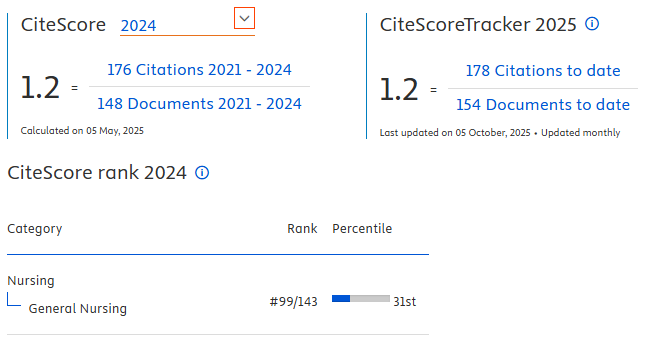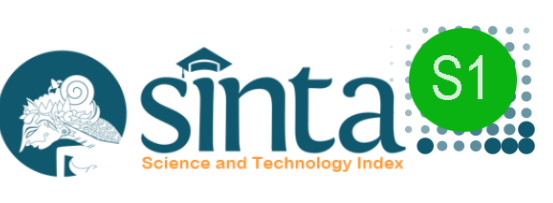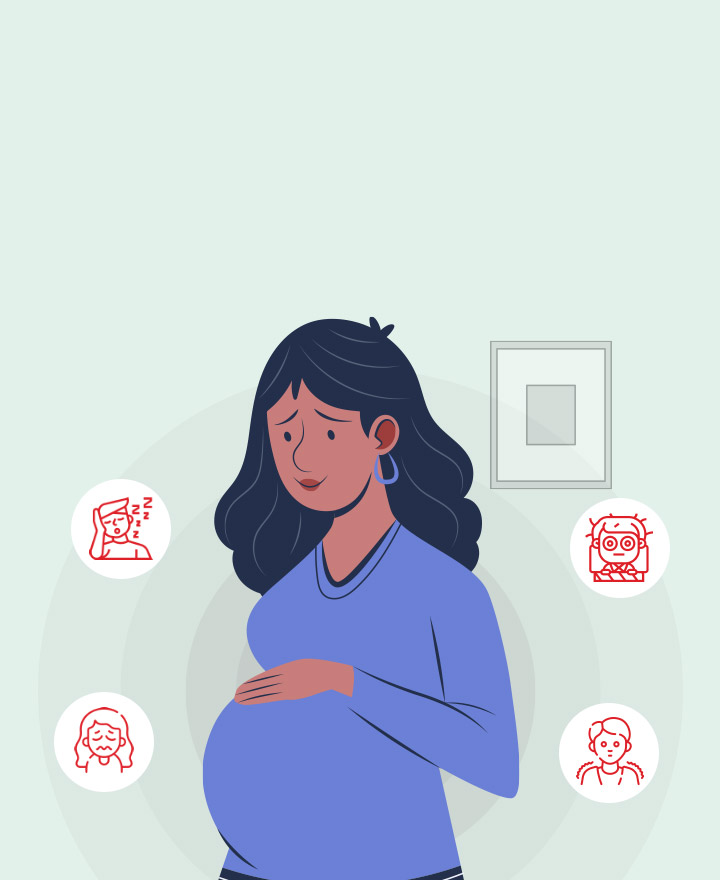Occupational stress levels among indonesian nurses and midwives in Saudi Arabian healthcare settings: a comparative cross-sectional study

Downloads
Introduction: This study aimed to assess the occupational stress levels among Indonesian nurses and midwives working in Saudi Arabian healthcare settings.
Methods: This cross-sectional comparative study assessed occupational stress among Indonesian nurses and midwives working in Saudi Arabia using the Expanded Nursing Stress Scale (ENSS). A total of 166 respondents (85 nurses and 81 midwives) completed the survey from a professional WhatsApp group. A convenience sampling was attempted, and only those who voluntarily responded to the questionnaire were included. The primary dependent variable was occupational stress, while the independent variables included profession (nurse and midwife), age, sex, education level, workplace setting, marital status, and years of experience. The analytical tests used were Mann-Whitney and Kruskal-Wallis.
Results: Occupational stress among nurses (Mean = 109) and midwives (Mean = 107) was low in psychological, physical, and social environments. Workload was the most stressful factor for both nurses (Mean = 20.44) and midwives (Mean = 18.88). We found a significant difference in the level of stress based on their workplace (p = 0.038) and educational background (p = 0.005). There was no difference in the level of stress between nurses and midwives (p = 0.188).
Conclusions: In comparison, either nurses or midwives have a low level of occupational stress, which is related to psychological, physical, and social environments based on ENSS tools. Therefore, optimal healthcare management and policy should be maintained and improved for migrant nurses and midwives to foster better, sustainable healthcare development in the future.
Abualruz, H. et al. (2024) ‘The role of psychological factors on improving work engagement among nurses’, (August), pp. 1–9. doi: 10.3389/fpsyg.2024.1419855.
Alanazy, W. and Aljohani, R. (2025) ‘The Role of Midwifery Workforce and Their Burnout in Hospitals of Saudi Arabia’, Advances in Human Biology. doi: 10.4103/aihb.aihb_193_24.
Alluhidan, M. et al. (2020) ‘Challenges and policy opportunities in nursing in Saudi Arabia’, Human Resources for Health, 18(1), p. 98. doi: 10.1186/s12960-020-00535-2.
Almansour, H. et al. (2023) ‘Migration of nurses and doctors: pull factors to work in Saudi Arabia’, Human Resources for Health, 21(1). doi: 10.1186/s12960-023-00809-5.
Al-Nusair, H. and Alnjadat, R. (2022) ‘Investigation of the Experience of Immigrant Nurses in a Diverse Cultural Setting’, Journal of Nursing Research, 30(3), p. E213. doi: 10.1097/jnr.0000000000000488.
Alruwaili, M. M. et al. (2022) ‘Experiences, Perceptions, and Coping Patterns of Emergency Department Nurses with Occupational Stressors in Saudi Arabian Hospitals: Mixed-Method Study’, Healthcare (Switzerland), 10(8). doi: 10.3390/healthcare10081504.
Dewe, P. and Cooper, C. (2020) Work and Stress: A Research Overview. doi: 10.4324/9780429331015.
Efendi, F. and Pradipta, R. O. (2025) ‘The Strategic Positioning of Indonesian Nurses in the International Healthcare Labor Market’. doi: 10.20473/jn.v20i1.70200.
Fahruddin, A. (2023) ‘Behavior of Indonesian Nurses Toward Non-Reported Needle Stick Injury in Saudi Arabia : A Phenomenological Study’, Jurnal Berita Ilmu Keperawatan, 16(2), pp. 211–219. doi: https://doi.org/10.23917/bik.v16i2.1882.
Fahruddin, A. (2025) ‘Experiences of Indonesian Nurses Facing Recognition Barriers in the Saudi Commission for Health Specialties: A Qualitative Study’, Jordan Journal of Nursing Research, 4(1). doi: 10.14525/JJNR.v4i1.04.
Fahruddin, A., Setyorini, D. and Saodah, S. (2024) ‘Departmental Workload and Job Satisfaction of Indonesian Nurses in Saudi Arabia: A Cross Sectional Study’, Jurnal Berita Ilmu Keperawatan, 17(2), pp. 124–131. doi: https://doi.org/10.23917/bik.v17i2.5501.
Harsono, H. (2024) ‘Validity and reliability of the Indonesian version of Expanded Nursing Stress Scale (ENSS) as a job-stress assessment tool for nurses’, e-Occupational and Environmental Medicine Journal of Indonesia, 2(1). doi: 10.7454/oemji.v2i1.1027.
ICN (2025) International Nurses Day 2025 Caring for Nurses Strengthens Economies Executive Summary 4 Intoduction 9.
Kurniati, A. et al. (2020) Analisis Kebijakan Pemenuhan Pasar Kerja Tenaga Kesehatan di Tingkat Global. Jakarta.
MOH (2024) ‘Indonesian Health Profile’. Available at: https://kemkes.go.id/id/profil-kesehatan-indonesia-2023 (Accessed: 25 May 2025).
Oe, M. et al. (2018) ‘Burnout, psychological symptoms, and secondary traumatic stress among midwives working on perinatal wards: A cross-cultural study between Japan and Switzerland’, Frontiers in Psychiatry, 9(SEP). doi: 10.3389/fpsyt.2018.00387.
Ohue, T. et al. (2021) ‘Cross-national comparison of factors related to stressors, burnout and turnover among nurses in developed and developing countries’, Nursing Open, 8(5), pp. 2439–2451. doi: 10.1002/nop2.1002.
Pradipta, R. O. et al. (2023) ‘The journey of Indonesian nurse migration: a scoping review’, Healthcare in Low-Resource Settings, 11(2). doi: 10.4081/hls.2023.11834.
Priyanto, E., Sukwika, T. and Hasibuan, B. (2022) ‘The influence of individual, environmental and organizational factors on the work stress among Indonesian nurses in Kuwait’, Malahayati International Journal of Nursing and Health Science, 5(2), pp. 76–90. doi: 10.33024/minh.v5i2.7988.
Raharto, A. and Noveria, M. (2020) ‘Nurse Migration and Career Development: The Indonesian Case’, ERIA, (1), p. 135.
Roth, C. et al. (2021) ‘Internationally trained nurses and host nurses’ perceptions of safety culture, work-life-balance, burnout, and job demand during workplace integration: a cross-sectional study’, BMC Nursing, 20(1). doi: 10.1186/s12912-021-00581-8.
Uswatin, N. et al. (2024) ‘Analysis of Burnout and Job Satisfaction with Intention to Leave among Indonesian Nurses in post Pandemic in Saudi Arabia’, Jurnal Berita Ilmu Keperawatan, 17(1), pp. 48–56. doi: 10.23917/bik.v17i1.3877.
Villamin, P. et al. (2025) ‘From Vulnerability to Stability: Migrant Nurses’ Experiences of Autonomy, Competence and Relatedness—A Qualitative Descriptive Study’, Journal of Nursing Management, 2025(1). doi: 10.1155/jonm/8260066.
Yektiningsih, E., Astari, A. M. and Utami, Y. W. (2021) ‘A Correlation between Working Environment and Job Experience Toward Culture Shock among Indonesian Nurses in Japan’, Jurnal Ners, 16(1), pp. 17–25. doi: 10.20473/jn.v16i1.23824.
Copyright (c) 2025 Jurnal Ners

This work is licensed under a Creative Commons Attribution 4.0 International License.
Authors who publish with Jurnal Ners agree to the following terms:
- Authors transfer the Copyright and grant Jurnal Ners the right of first publication with the work simultaneously licensed under a Creative Commons Attribution 4.0 International License that allows others to remix, adapt and build upon the work with an acknowledgment of the work's authorship and of the initial publication in Jurnal Ners.
- Authors are permitted to copy and redistribute the journal's published version of the work (e.g., post it to an institutional repository or publish it in a book), with an acknowledgment of its initial publication in Jurnal Ners.
Jurnal Ners requires a formal written declaration and transfer of copyright from the author(s) for each article published. We, therefore, ask you to complete and return this form, retaining a copy for your own records. Your cooperation is essential and appreciated. Any delay will result in a delay in publication. The form can be downloaded HERE.
































